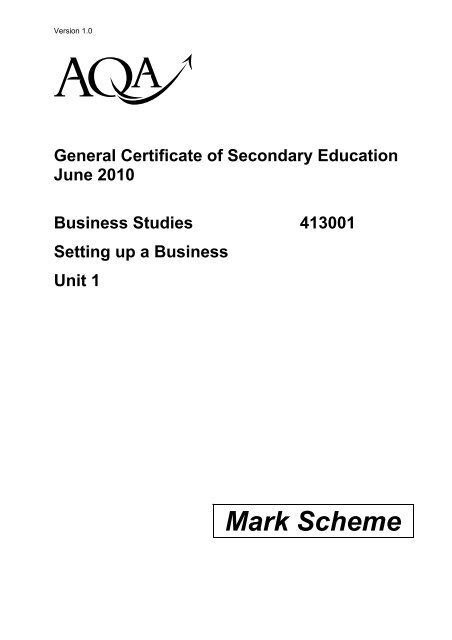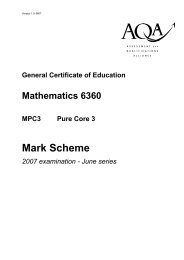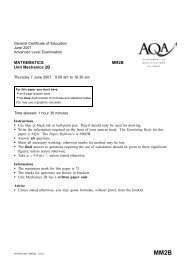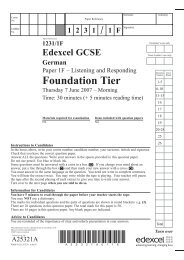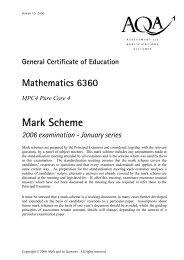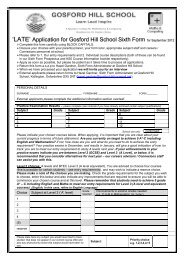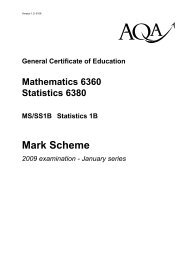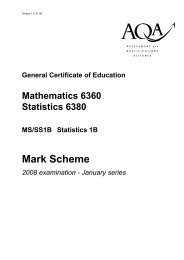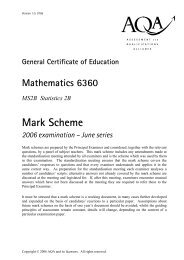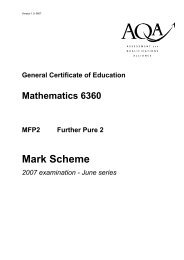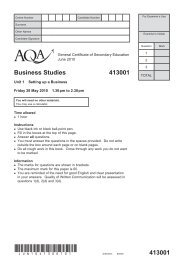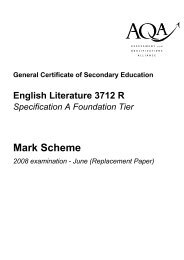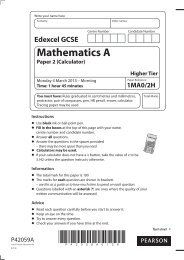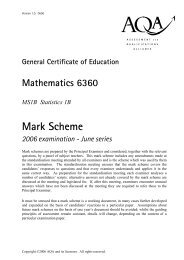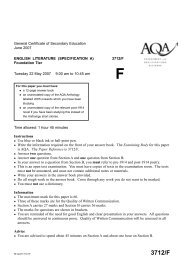Mark Scheme - Revision World
Mark Scheme - Revision World
Mark Scheme - Revision World
You also want an ePaper? Increase the reach of your titles
YUMPU automatically turns print PDFs into web optimized ePapers that Google loves.
Version 1.0<br />
klm<br />
General Certificate of Secondary Education<br />
June 2010<br />
Business Studies 413001<br />
Setting up a Business<br />
Unit 1<br />
<strong>Mark</strong> <strong>Scheme</strong>
<strong>Mark</strong> schemes are prepared by the Principal Examiner and considered, together with the<br />
relevant questions, by a panel of subject teachers. This mark scheme includes any<br />
amendments made at the standardisation meeting attended by all examiners and is the scheme<br />
which was used by them in this examination. The standardisation meeting ensures that the<br />
mark scheme covers the candidates’ responses to questions and that every examiner<br />
understands and applies it in the same correct way. As preparation for the standardisation<br />
meeting each examiner analyses a number of candidates’ scripts: alternative answers not<br />
already covered by the mark scheme are discussed at the meeting and legislated for. If, after<br />
this meeting, examiners encounter unusual answers which have not been discussed at the<br />
meeting they are required to refer these to the Principal Examiner.<br />
It must be stressed that a mark scheme is a working document, in many cases further<br />
developed and expanded on the basis of candidates’ reactions to a particular paper.<br />
Assumptions about future mark schemes on the basis of one year’s document should be<br />
avoided; whilst the guiding principles of assessment remain constant, details will change,<br />
depending on the content of a particular examination paper.<br />
Further copies of this <strong>Mark</strong> <strong>Scheme</strong> are available to download from the AQA Website: www.aqa.org.uk<br />
Copyright © 2010 AQA and its licensors. All rights reserved.<br />
COPYRIGHT<br />
AQA retains the copyright on all its publications. However, registered centres for AQA are permitted to copy material<br />
from this booklet for their own internal use, with the following important exception: AQA cannot give permission to<br />
centres to photocopy any material that is acknowledged to a third party even for internal use within the centre.<br />
Set and published by the Assessment and Qualifications Alliance.<br />
The Assessment and Qualifications Alliance (AQA) is a company limited by guarantee registered in England and Wales (company number 3644723) and a registered charity (registered charity number 1073334).<br />
Registered address: AQA, Devas Street, Manchester M15 6EX
Business Studies - AQA GCSE <strong>Mark</strong> <strong>Scheme</strong> 2010 June series<br />
1 Total for this question: 21 marks<br />
1 (a) State and explain one reason why Emily might want to start up her own business.<br />
(2 marks)<br />
Reasons could be:<br />
Internal - wants to make money; wants to run her own business.<br />
or<br />
External - seen a gap in the market.<br />
One mark for stating a point plus one mark for development.<br />
Example:<br />
She has seen a gap in the market (1) which means she could make a profit (1).<br />
A01 – 1 mark.<br />
A02 – 1 mark.<br />
1 (b) Emily and Isabella are planning to set up their business as a partnership.<br />
Explain two benefits to them of setting up the business as a partnership.<br />
(4 marks)<br />
Benefits of partnership could be:<br />
• more ideas<br />
• more money<br />
• more/different skills<br />
• share responsibility/workload/decisions<br />
• cheap to set up (vs. a company).<br />
One mark for benefit and one mark for explanation of either the benefit or how they would<br />
benefit.<br />
Example:<br />
They could specialize in different jobs (1) Emily could do the finance, Isabella the marketing.<br />
A01 – 2 marks.<br />
A02 – 2 marks.<br />
3
Business Studies - AQA GCSE <strong>Mark</strong> <strong>Scheme</strong> 2010 June series<br />
1 (c) Emily and Isabella are considering carrying out some market research before they<br />
start up the business.<br />
Methods could be primary or secondary (terms not required):<br />
Primary:<br />
• potential customer questionnaires<br />
• potential customer interviews<br />
• informal discussions<br />
• observations, eg Emily’s own move.<br />
Secondary:<br />
• house move data<br />
• population, eg socioeconomic, data<br />
• competitor information.<br />
One mark for identifying the method, one mark for describing the method and one mark for<br />
describing how it could be used to help them see if their business is likely to succeed.<br />
Example:<br />
They could look at competitors’ websites (1) to find out their prices (1) so they could charge the<br />
same or less (1).<br />
A01 – 2 marks.<br />
A02 – 4 marks.<br />
State and explain two methods of market research that they could use to help them<br />
see whether their business is likely to succeed.<br />
(6 marks)<br />
4
Business Studies - AQA GCSE <strong>Mark</strong> <strong>Scheme</strong> 2010 June series<br />
1 (d) Emily and Isabella need to buy a suitable van for the business which is likely to cost<br />
about £10 000. They could either:<br />
• borrow £10 000 from one of Isabella’s relatives or<br />
• see whether the local bank will give them a loan over five years.<br />
Emily is not sure that involving Isabella’s family would be a good idea.<br />
Advise Emily and Isabella on which would be the better source of finance for them.<br />
Give reasons for your advice.<br />
(9 marks)<br />
Possible areas for discussion include:<br />
Family:<br />
• available, possibly quickly<br />
• may be interest free<br />
• unclear for how long<br />
• may cause family disputes.<br />
Bank loan:<br />
• may not be available<br />
• will cost interest<br />
• loan period defined<br />
• available (possibly quickly) with business advice.<br />
Level Descriptor <strong>Mark</strong>s<br />
3<br />
2<br />
1<br />
Candidate offers advice with good justification.<br />
Ideas are communicated with a clear structure and<br />
use of technical terms.<br />
Candidate offers advice with some valid justification.<br />
Ideas are communicated with some structure and use<br />
of technical terms. There are occasional errors in<br />
accepted convention.<br />
Candidate offers advice with limited support.<br />
Ideas are communicated in a simplistic way with<br />
limited use of technical terms. Errors in accepted<br />
conventions are noticeable.<br />
7–6<br />
5–3<br />
2–1<br />
Assessment<br />
Objective<br />
AO3 and<br />
Quality of<br />
Written<br />
Communication<br />
Note: AO3 also assesses candidates’ quality of written communication. When deciding on the<br />
AO3 level to be awarded, consider the degree to which the candidate orders and<br />
communicates his/her ideas.<br />
In addition, and separately, award marks for knowledge and application using the grid<br />
below.<br />
Level Descriptor <strong>Mark</strong>s<br />
Assessment<br />
Objective<br />
2 Candidate provides explanation of point(s) in context. 2 AO2<br />
1 Candidate states relevant point(s). 1<br />
0 No valid response. 0<br />
AO1<br />
5
Business Studies - AQA GCSE <strong>Mark</strong> <strong>Scheme</strong> 2010 June series<br />
2 Total for this question: 20 marks<br />
2 (a) List three different ways in which Expresso Printing Ltd could advertise for the two new<br />
employees.<br />
(3 marks)<br />
These could include:<br />
• job centre<br />
• local newspaper (allow newspaper)<br />
• local radio<br />
• small ads/cards in shops<br />
• community/local websites<br />
• noticeboard at current location.<br />
Do not allow general or unsuitable options, eg national newspapers, TV, radio.<br />
One mark for each correct response.<br />
A01 – 3 marks.<br />
2 (b) The following advertisement has been used to attract people to apply for the two new<br />
jobs.<br />
Explain two features of the advertisement that make it unsuitable.<br />
(4 marks)<br />
Weaknesses could include:<br />
• no real detail about the job (allow one or two examples)<br />
• no location details<br />
• who to call<br />
• age discrimination<br />
• pressurised<br />
• qualifications not listed.<br />
Level Descriptor <strong>Mark</strong>s<br />
Assessment<br />
Objective<br />
2 Candidate explains way(s) that the advert is unsuitable. 4–3 AO2<br />
1<br />
Candidate identifies characteristics missing from the<br />
advert.<br />
0 No valid response. 0<br />
2–1<br />
AO1<br />
Example:<br />
The advert tells you the job has brilliant wages but does not tell you what they are (L1).<br />
People are not going to apply for a job unless they know the wage is high enough (L2).<br />
6
Business Studies - AQA GCSE <strong>Mark</strong> <strong>Scheme</strong> 2010 June series<br />
2 (c) Explain two ways that Expresso Printing Ltd could motivate its two new employees.<br />
(4 marks)<br />
Methods of motivation could include:<br />
• training<br />
• greater responsibility<br />
• financial rewards.<br />
Level Descriptor <strong>Mark</strong>s<br />
2<br />
Candidate explains how motivation method would be<br />
used to motivate new employees.<br />
1 Candidate identifies motivation method. 2–1<br />
0 No valid response. 0<br />
Assessment<br />
Objective<br />
4–3 AO2<br />
AO1<br />
Example:<br />
Employees are motivated by many factors; pay, fringe benefits and working conditions (L1).<br />
For new employees they should be given induction training as this will help them know what<br />
they are doing and feel good about their new job (L2).<br />
Allow three marks for one way that is very well explained.<br />
7
Business Studies - AQA GCSE <strong>Mark</strong> <strong>Scheme</strong> 2010 June series<br />
2 (d) Expresso Printing Ltd is aware that, to remain competitive, it needs to introduce more<br />
technology into its production process by buying a new computerised colour printer.<br />
The new printer would produce high quality colour posters and leaflets more cheaply<br />
which would allow Expresso Printing Ltd to reduce its prices.<br />
The new printer would cost a very large sum of money and would double the amount<br />
of the loan that Expresso Printing Ltd has with the bank. It would, however, be<br />
cheaper to run than the company’s present printer.<br />
Using Item B and the text above, advise Expresso Printing Ltd whether it should<br />
purchase the machine. Give reasons for your advice.<br />
(9 marks)<br />
Possible areas for discussion include:<br />
Reasons for new technology/new machine:<br />
• improve quality<br />
• reduced running costs<br />
• allow Expresso Printing Ltd to be more competitive.<br />
Reasons against new technology:<br />
• initial cost<br />
• workers may lose jobs<br />
• may break down<br />
• will become out-of-date.<br />
Level Descriptor <strong>Mark</strong>s<br />
3<br />
2<br />
1<br />
Candidate offers advice with good justification.<br />
Ideas are communicated with a clear structure and<br />
use of technical terms.<br />
Candidate advice with some valid justification.<br />
Ideas are communicated with some structure and use<br />
of technical terms. There are occasional errors in<br />
accepted convention.<br />
Candidate offers advice with limited support.<br />
Ideas are communicated in a simplistic way with<br />
limited use of technical terms. Errors in accepted<br />
conventions are noticeable.<br />
7–6<br />
5–3<br />
2–1<br />
Assessment<br />
Objective<br />
AO3 and<br />
Quality of<br />
Written<br />
Communication<br />
Note: AO3 also assesses candidates’ quality of written communication. When deciding on the<br />
AO3 level to be awarded, consider the degree to which the candidate orders and communicates<br />
his/her ideas.<br />
In addition, and separately, award marks for knowledge and application using the grid below.<br />
Level Descriptor <strong>Mark</strong>s<br />
8<br />
Assessment<br />
Objective<br />
2 Candidate provides explanation of point(s) in context. 2 AO2<br />
1 Candidate states relevant point(s). 1<br />
0 No valid response. 0<br />
AO1
Business Studies - AQA GCSE <strong>Mark</strong> <strong>Scheme</strong> 2010 June series<br />
3 Total for this question: 19 marks<br />
3 (a) Explain one possible reason why the profits of Good for Us might have decreased.<br />
(2 marks)<br />
Any possible reason, ie sales/revenue has fallen, costs have increased, external factors<br />
(recession, competition).<br />
One mark for stating reason, one mark for development. Allow examples.<br />
Example:<br />
It is selling less produce (1) because the supermarket has taken its customers (1).<br />
A02 – 2 marks.<br />
3 (b) Explain two possible effects on Good for Us of lowering its prices. (4 marks)<br />
Effects of lowering prices could be:<br />
• sell more products<br />
• become more competitive<br />
• receive less money per product<br />
• increased revenue and/or profits.<br />
One mark for effect and one mark for explanation of effect on Good for Us. Apply twice.<br />
Example:<br />
They will sell more products (1) which may increase revenue (1). However, their costs are also<br />
going up (1) because they are buying more stock (1).<br />
Allow three marks for one way that is very well explained.<br />
9
Business Studies - AQA GCSE <strong>Mark</strong> <strong>Scheme</strong> 2010 June series<br />
3 (c) Good for Us prides itself in providing good customer service.<br />
Explain two ways Good for Us could provide good customer service.<br />
(4 marks)<br />
Possible examples could be:<br />
• making sure products are good quality<br />
• clear product information/labelling<br />
• good after-sales/follow up service<br />
• friendly and polite.<br />
Level Descriptor <strong>Mark</strong>s<br />
2<br />
Candidate explains way(s) which Good for Us Ltd could<br />
use to provide good customer service.<br />
1 Candidate explains customer service. 2–1<br />
0 No valid response. 0<br />
Assessment<br />
Objective<br />
4–3 AO2<br />
AO1<br />
Example:<br />
Customers expect good service when they buy products (L1). This means Good for Us should<br />
pack customers’ bags and offer home delivery service (L2).<br />
10
Business Studies - AQA GCSE <strong>Mark</strong> <strong>Scheme</strong> 2010 June series<br />
3 (d) In order to help increase its profits, Good for Us has decided to increase its advertising.<br />
It has found out the following information:<br />
<br />
• providing leaflets for distribution would cost £500 for 5000 leaflets<br />
• advertising in the local weekly newspaper would cost £1000 (20 000 copies of the<br />
newspaper are sold each week).<br />
Recommend which method Good for Us should use in order to increase its profits.<br />
Give reasons for your recommendation.<br />
(9 marks)<br />
Leafleting is more expensive per head (10p per leaflet) but could be accurately targeted. More<br />
likely to be kept but needs to be designed and delivered. Need time to deliver/may be seen as<br />
junk mail.<br />
Advertising is cheaper per head (5p per reader) but is indiscriminate. Not everyone will get/read<br />
the paper and less likely to be kept. Will also need to design the advert. Lets competition know<br />
what it is doing.<br />
Level Descriptor <strong>Mark</strong>s<br />
3<br />
2<br />
Candidate offers recommendation with good<br />
justification.<br />
Ideas are communicated with a clear structure and<br />
use of technical terms.<br />
Candidate offers recommendation with some valid<br />
justification.<br />
Ideas are communicated with some structure and use<br />
of technical terms. There are occasional errors in<br />
accepted convention.<br />
1 Candidate offers judgement with limited support.<br />
Ideas are communicated in a simplistic way with<br />
limited use of technical terms. Errors in accepted<br />
conventions are noticeable.<br />
7–6<br />
5–3<br />
2–1<br />
Assessment<br />
Objective<br />
AO3 and<br />
Quality of<br />
Written<br />
Communication<br />
Note: AO3 also assesses candidates’ quality of written communication. When deciding on the<br />
AO3 level to be awarded, consider the degree to which the candidate orders and<br />
communicates his/her ideas.<br />
In addition, and separately, award marks for knowledge and application using the grid below.<br />
Level Descriptor <strong>Mark</strong>s<br />
Assessment<br />
Objective<br />
2 Candidate provides explanation of point(s) in context. 2 AO2<br />
1 Candidate states relevant point(s). 1<br />
0 No valid response. 0<br />
AO1<br />
11


